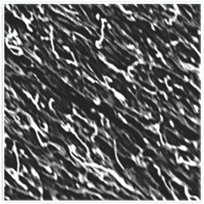Crossref Citations
This article has been cited by the following publications. This list is generated based on data provided by
Crossref.
Gupta, Maneesh K.
Wagner, Drew T.
and
Jewett, Michael C.
2020.
Engineered proteins as multifunctional materials.
MRS Bulletin,
Vol. 45,
Issue. 12,
p.
999.
Afroj, Shaila
Britnell, Liam
Hasan, Tahmid
Andreeva, Daria V.
Novoselov, Kostya S.
and
Karim, Nazmul
2021.
Graphene‐Based Technologies for Tackling COVID‐19 and Future Pandemics.
Advanced Functional Materials,
Vol. 31,
Issue. 52,
Rey, Valentina
Abatedaga, Inés
Vera, Cecilia
Vieyra, Faustino E. Morán
and
Borsarelli, Claudio D.
2021.
Photosensitized Formation of Soluble Bionanoparticles of Lysozyme.
ChemistrySelect,
Vol. 6,
Issue. 47,
p.
13443.
Cao, Sisi
Wu, Xuanhao
Zhu, Yaguang
Gupta, Prashant
Martinez, Adrian
Zhang, Yunzhu
Ghim, Deoukchen
Wang, Yixuan
Liu, Lin
Jun, Young-Shin
and
Singamaneni, Srikanth
2021.
MXene aerogel for efficient photothermally driven membrane distillation with dual-mode antimicrobial capability.
Journal of Materials Chemistry A,
Vol. 9,
Issue. 39,
p.
22585.
Zhytniakivska, Olga
Kurutos, Atanas
Shchuka, Mykhailo
Vus, Kateryna
Tarabara, Uliana
Trusova, Valeriya
and
Gorbenko, Galyna
2021.
Fӧrster resonance energy transfer between Thioflavin T and unsymmetrical trimethine cyanine dyes on amyloid fibril scaffold.
Chemical Physics Letters,
Vol. 785,
Issue. ,
p.
139127.
Tarabara, Uliana
Zhytniakivska, Olga
Vus, Kateryna
Trusova, Valeriya
and
Gorbenko, Galyna
2022.
Fluorescence Study of the Interactions Between Insulin Amyloid Fibrils and Proteins.
East European Journal of Physics,
p.
96.
Zhao, Shouwei
Chen, Zhiwei
Dong, Yaqi
Lu, Wenhui
and
Zhu, Deyi
2022.
The Preparation and Properties of Composite Hydrogels Based on Gelatin and (3-Aminopropyl) Trimethoxysilane Grafted Cellulose Nanocrystals Covalently Linked with Microbial Transglutaminase.
Gels,
Vol. 8,
Issue. 3,
p.
146.
Cao, Yanju
Zhang, Jingqiong
Wei, Sainan
and
Zhang, Haichang
2022.
Application and Safety Performance of Nanomaterials in Clothing Design Engineering.
Advances in Materials Science and Engineering,
Vol. 2022,
Issue. ,
p.
1.
Jang, Daseul
Beckett, Laura E.
Keum, Jong
and
Korley, LaShanda T.J.
2023.
Leveraging peptide–cellulose interactions to tailor the hierarchy and mechanics of peptide–polymer hybrids.
Journal of Materials Chemistry B,
Vol. 11,
Issue. 24,
p.
5594.
Krishna, Abhijith
V.T., Arya
D., Geethanjali
Joji, Jeffy
and
John, Neetha
2024.
Advances in Bionanocomposites.
p.
211.
Pradhan, Sayantan
and
Yadavalli, Vamsi K.
2024.
Silk-Based Biomaterials for Tissue Engineering, Regenerative and Precision Medicine.
p.
735.
Jang, Daseul
Wong, Yu-Tai
and
Korley, LaShanda T. J.
2025.
A bio-inspired approach to engineering water-responsive, mechanically-adaptive materials.
Molecular Systems Design & Engineering,
Vol. 10,
Issue. 4,
p.
264.
Kapoor, Sakshi
and
Ahmad, Hilal
2025.
Protein-Based Nanocomposites for Tissue Engineering.
p.
69.
Jamjoum, Hayfa Alajilani Abraheem
Umar, Khalid
Adnan, Rohana
Parveen, Tabassum
Jayanudin
and
Fadlullah, H.
2025.
Protein-Based Nanocomposites for Tissue Engineering.
p.
95.
Jameel, Mohd
Fatma, Homa
Umar, Khalid
and
Siddique, Hifzur R.
2025.
Protein-Based Nanocomposites for Tissue Engineering.
p.
17.
Vural, Mert
and
Demirel, Melik C.
2025.
Biocomposites of 2D layered materials.
Nanoscale Horizons,
Vol. 10,
Issue. 4,
p.
664.
Umar, Khalid
Parveen, Tabassum
Bhawani, Showkat Ahmad
Jayanudin
Jameel, Mohd
and
Hussin, M. Hazwan
2025.
Protein-Based Nanocomposites for Tissue Engineering.
p.
37.
